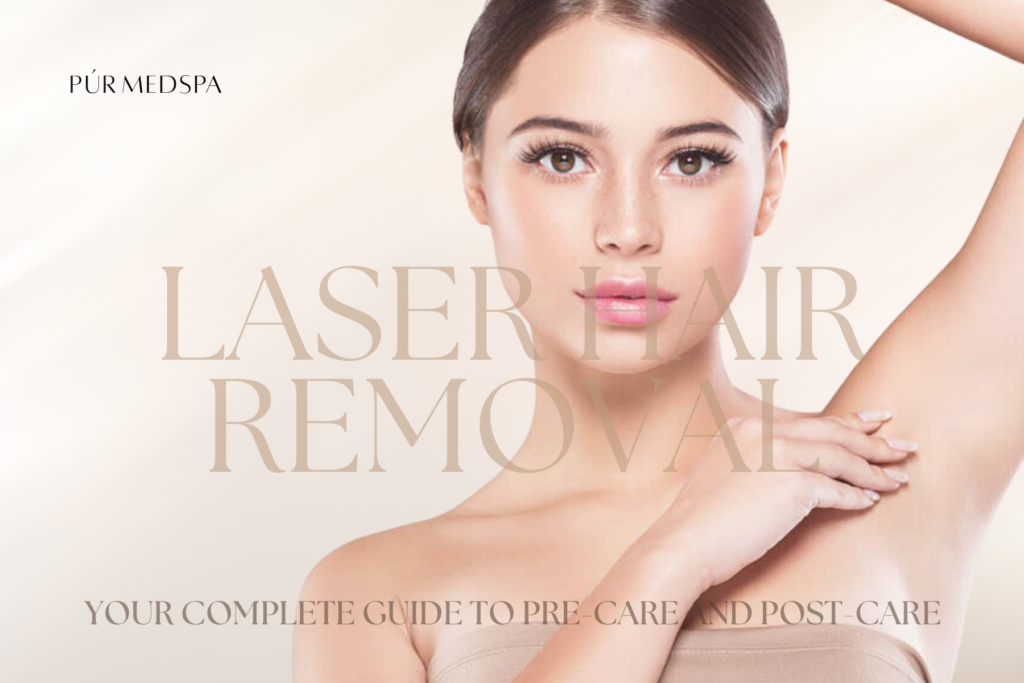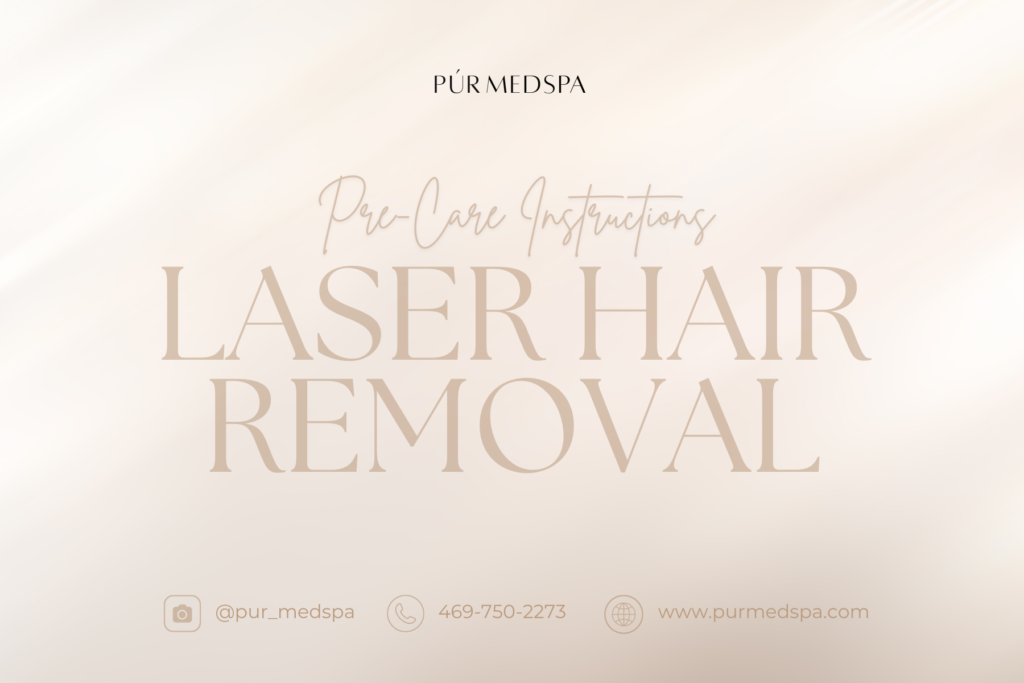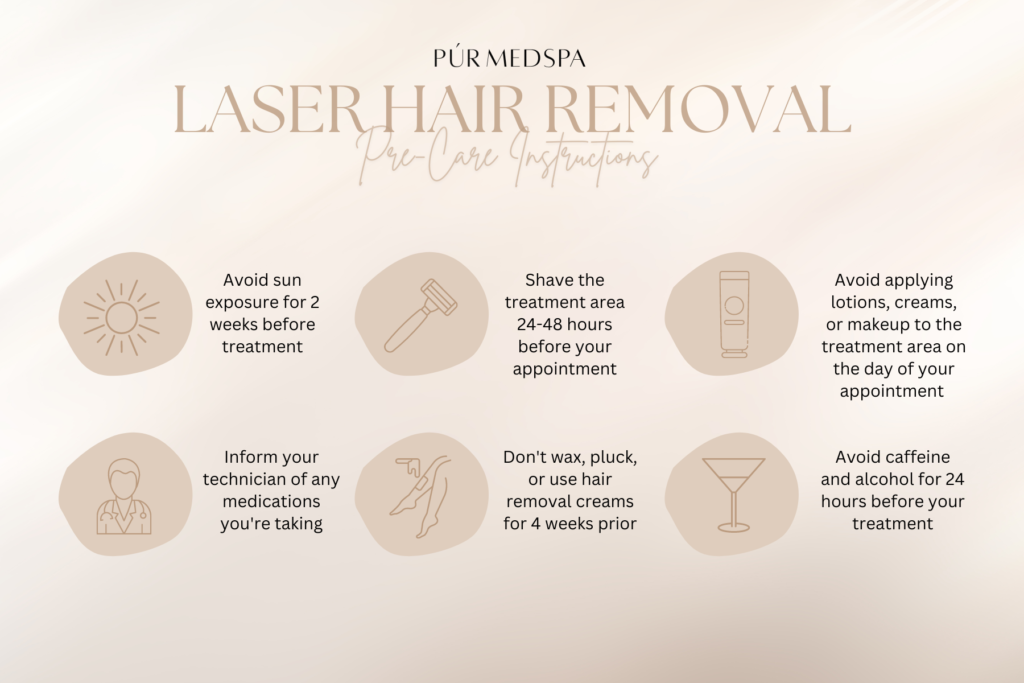Introduction
At Pur MedSpa, with locations in Plano, Frisco, and Southlake, we offer advanced laser hair removal treatments to help you achieve long-term hair reduction and smooth skin. Whether you’re looking to reduce hair growth on your face, legs, arms, underarms, back, or bikini area, laser hair removal is a safe, effective solution for both men and women. To ensure the best results and minimize potential side effects, proper pre-care and post-care instructions are critical. This guide will take you through everything you need to know before and after your laser hair removal treatment, including who may not be eligible for the procedure.

What is Laser Hair Removal?
Laser hair removal uses concentrated light beams to target and destroy the hair follicles, which inhibits future hair growth. It’s a highly effective treatment for a variety of skin types and hair colors, though results can vary depending on individual factors such as hair thickness, skin type, and hormonal changes. Laser hair removal is a popular choice for those seeking a long-term solution to unwanted hair, whether you’re dealing with facial hair, body hair, or sensitive areas like the bikini line.
Why Choose Laser Hair Removal at Pur MedSpa?
- Cutting-edge technology designed for safety and efficiency.
- Customized treatments tailored to your skin type and hair color.
- Experienced providers with expertise in laser technology.
- Convenient locations in Plano, Frisco, and Southlake.
Laser hair removal is a versatile and effective cosmetic procedure that caters to both men and women, aiming to reduce unwanted hair and simplify personal grooming routines. While the fundamental technology and process remain consistent across genders, the specific areas of focus and underlying reasons for choosing laser hair removal often vary.
Laser Hair Removal For Women
Many women turn to laser hair removal for a variety of areas, including but not limited to:
- Face: Targeting the upper lip, chin, and cheeks to achieve a flawless, hair-free complexion.
- Underarms: To eliminate the inconvenience of daily shaving and the discomfort of stubble.
- Legs: For long-lasting smoothness and the freedom to wear shorts or skirts without worry.
- Bikini Line or Brazilian: To confidently wear swimwear and lingerie without concerns about ingrown hairs or shaving bumps.
- Arms: To reduce or eliminate the visibility of arm hair for a silkier feel.
Women often find laser hair removal a game-changer, particularly for those looking for a long-term solution to managing body hair. It’s not only about aesthetics but also about convenience and comfort. For women dealing with hormonal imbalances, such as those associated with PCOS, which can lead to hirsutism (excessive hair growth), laser hair removal can be a transformative and empowering treatment option.
Laser Hair Removal For Men
Men typically seek laser hair removal for areas including:
- Back: To address hair growth that cannot be easy to manage independently.
- Chest: For a cleaner look or to highlight muscle definition.
- Shoulders: To maintain a groomed appearance without the hassle of regular shaving.
- Neck: To prevent ingrown hairs and maintain a neat hairline, particularly at the back of the neck.
- Beard Shaping: To define the edges of a beard, reduce ingrown hairs, and minimize shaving time.
For men, laser hair removal is not just about aesthetics but also practicality. It offers a solution to the irritation and time consumption of traditional hair removal methods like shaving and waxing. Athletes, such as swimmers and bodybuilders, may find laser hair removal particularly beneficial, as it helps to maintain a hair-free body, which can be a requirement or preference in their sports. Additionally, men who suffer from pseudofolliculitis barbae, commonly known as razor bumps, may find relief through laser treatments, which can reduce these often painful and unsightly skin issues.
Age Groups and Laser Hair Removal
Laser hair removal can be performed on a wide range of age groups, with people of all ages seeking the benefits of smoother, hair-free skin. While the treatment is most popular among those in their 20s and 30s, many teens and older adults also benefit from the procedure.
Laser Hair Removal for Teens (16-19):
Young adults are the largest group seeking laser hair removal, as they look for a long-term solution to shaving or waxing. This group often focuses on areas such as the legs, bikini line, underarms, and facial hair.
Laser Hair Removal for Young Adults (20-35):
Young adults are the largest group seeking laser hair removal, as they look for a long-term solution to shaving or waxing. This group often focuses on areas such as the legs, bikini line, underarms, and facial hair.
Laser Hair Removal for Adults (35-50):
For adults, laser hair removal is often integrated into a comprehensive skincare and grooming routine. As hormonal changes related to aging or pregnancy can cause unwanted hair growth, many adults turn to laser treatments to target specific areas such as the face, back, chest, and bikini line. The convenience of reduced hair growth becomes even more valuable as they juggle busy professional and personal lives.
Laser Hair Removal for Older Adults (50+):
Laser hair removal is also becoming more popular among older adults, especially those who want to address hormonal hair growth changes related to menopause or aging. Many older individuals seek to reduce facial hair or body hair for personal grooming reasons or to maintain smoother skin as they age. With advancements in laser technology, the procedure is safer and more effective for older skin, and it’s a convenient option for those tired of traditional hair removal methods like shaving or waxing.
While older individuals may experience thinning hair or graying of hair follicles, laser treatments can still be effective depending on the hair color and texture.
Why You Should Consider Laser Hair Removal Before Thinning or Graying Hair
As we age, many individuals experience thinning or graying hair, which can significantly affect the efficacy of laser hair removal. Laser technology targets the pigment (melanin) in hair follicles, meaning darker hair responds best to the treatment. As hair begins to thin or turn gray, it loses the pigment that makes it an ideal candidate for laser treatment. Laser hair removal becomes less effective once hair becomes gray or white, as the laser has less melanin to target.
If you’re considering laser hair removal and are noticing early signs of thinning or graying hair, it’s essential to begin treatment sooner rather than later. By starting laser hair removal before these conditions become prominent, you can maximize the effectiveness of each session and achieve smoother, hair-free skin in the long term. Don’t wait until it’s too late—laser hair removal works best on pigmented hair, so scheduling your treatment early can ensure the best possible results.

Pre-Care Instructions for Laser Hair Removal
Pre-Care Instructions for Laser Hair Removal
- Sun Protection:
- Avoid sun exposure for at least 2 weeks before your treatment to minimize the risk of burns or hyperpigmentation.
- If sun exposure is unavoidable, use SPF 50+ sunscreen on the treatment area.
- Hair Removal:
- Do not wax, pluck, or use hair removal creams for 4 weeks before your appointment as these methods remove the hair from the follicle, which is necessary for laser hair removal.
- Shave the treatment area 24-48 hours before your appointment to ensure that the laser can effectively target the hair follicles without burning surface hair.
- Skincare:
- Avoid applying lotions, creams, or makeup to the treatment area on the day of your session.
- Stop using retinoids, glycolic acids, or other harsh skincare products 7 days before your treatment to avoid irritation.
- Medications:
- Inform your Pur MedSpa technician of any medications you’re currently taking, especially those that may affect skin sensitivity.
- Avoid antibiotics and photosensitizing medications for 10 days prior to your treatment as they can increase skin sensitivity.
- Lifestyle:
- Avoid caffeine and alcohol for 24 hours before your session to reduce the risk of swelling or irritation.
- Medical Conditions:
- Notify your provider of any medical conditions, such as skin disorders or immune system issues, that may affect your eligibility for treatment.
If you’re considering laser hair removal and are noticing early signs of thinning or graying hair, it’s essential to begin treatment sooner rather than later. By starting laser hair removal before these conditions become prominent, you can maximize the effectiveness of each session and achieve smoother, hair-free skin in the long term. Don’t wait until it’s too late—laser hair removal works best on pigmented hair, so scheduling your treatment early can ensure the best possible results.

